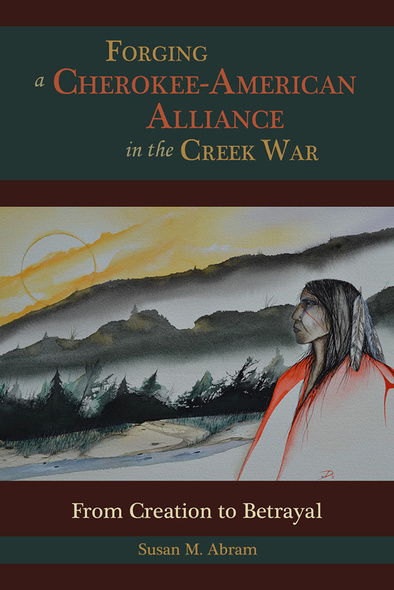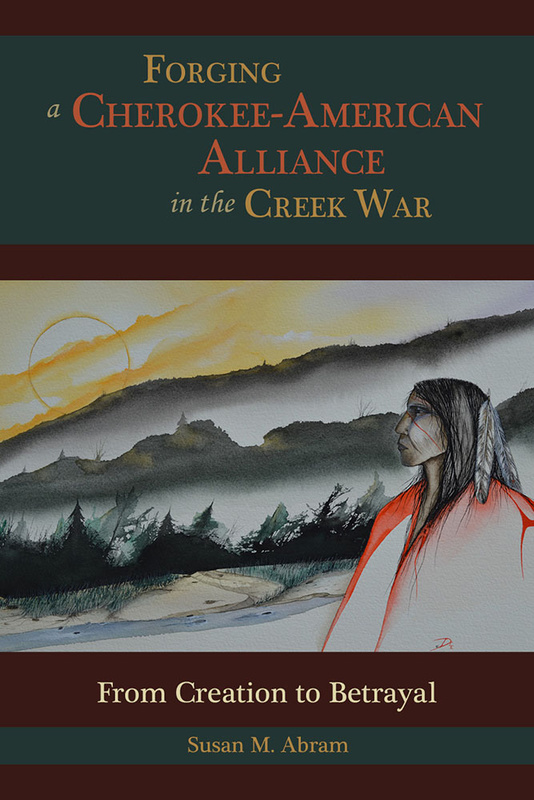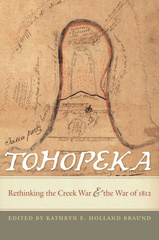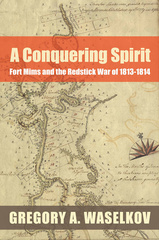
240 pages, 6 x 9
8 b&w illustrations, including 3 maps - 2 tabl
Hardcover
Release Date:15 Nov 2015
ISBN:9780817318758
Forging a Cherokee-American Alliance in the Creek War
From Creation to Betrayal
University of Alabama Press
Explores how the Creek War of 1813–1814 not only affected Creek Indians but also acted as a catalyst for deep cultural and political transformation within the society of the United States’ Cherokee allies
The Creek War of 1813–1814 is studied primarily as an event that impacted its two main antagonists, the defending Creeks in what is now the State of Alabama and the expanding young American republic. Scant attention has been paid to how the United States’ Cherokee allies contributed to the war and how the war transformed their society. In Forging a Cherokee-American Alliance in the Creek War, Susan M. Abram explains in engrossing detail the pivotal changes within Cherokee society triggered by the war that ultimately ended with the Cherokees’ forced removal by the United States in 1838.
The Creek War (also known as the Red Stick War) is generally seen as a local manifestation of the global War of 1812 and a bright footnote of military glory in the dazzling rise of Andrew Jackson. Jackson’s victory, which seems destined only in historic hindsight, was greatly aided by Cherokee fighters. Yet history has both marginalized Cherokee contributions to that conflict and overlooked the fascinating ways Cherokee society changed as it strove to accommodate, rationalize, and benefit from an alliance with the expanding American republic. Through the prism of the Creek War and evolving definitions of masculinity and community within Cherokee society, Abram delineates as has never been done before the critical transitional decades prior to the Trail of Tears.
Deeply insightful, Abram illuminates the ad hoc process of cultural, political, and sometimes spiritual transitions that took place among the Cherokees. Before the onset of hostilities, the Cherokees already faced numerous threats and divisive internal frictions. Abram concisely records the Cherokee strategies for meeting these challenges, describing how, for example, they accepted a centralized National Council and replaced the tradition of conflict-resolution through blood law with a network of “lighthorse regulators.” And while many aspects of masculine war culture remained, it too was filtered and reinterpreted through contact with the legalistic and structured American military.
Rigorously documented and persuasively argued, Abram’s award-winning Forging a Cherokee-American Alliance in the Creek War fills a critical gap in the history of the early American republic, the War of 1812, the Cherokee people, and the South.
The Creek War of 1813–1814 is studied primarily as an event that impacted its two main antagonists, the defending Creeks in what is now the State of Alabama and the expanding young American republic. Scant attention has been paid to how the United States’ Cherokee allies contributed to the war and how the war transformed their society. In Forging a Cherokee-American Alliance in the Creek War, Susan M. Abram explains in engrossing detail the pivotal changes within Cherokee society triggered by the war that ultimately ended with the Cherokees’ forced removal by the United States in 1838.
The Creek War (also known as the Red Stick War) is generally seen as a local manifestation of the global War of 1812 and a bright footnote of military glory in the dazzling rise of Andrew Jackson. Jackson’s victory, which seems destined only in historic hindsight, was greatly aided by Cherokee fighters. Yet history has both marginalized Cherokee contributions to that conflict and overlooked the fascinating ways Cherokee society changed as it strove to accommodate, rationalize, and benefit from an alliance with the expanding American republic. Through the prism of the Creek War and evolving definitions of masculinity and community within Cherokee society, Abram delineates as has never been done before the critical transitional decades prior to the Trail of Tears.
Deeply insightful, Abram illuminates the ad hoc process of cultural, political, and sometimes spiritual transitions that took place among the Cherokees. Before the onset of hostilities, the Cherokees already faced numerous threats and divisive internal frictions. Abram concisely records the Cherokee strategies for meeting these challenges, describing how, for example, they accepted a centralized National Council and replaced the tradition of conflict-resolution through blood law with a network of “lighthorse regulators.” And while many aspects of masculine war culture remained, it too was filtered and reinterpreted through contact with the legalistic and structured American military.
Rigorously documented and persuasively argued, Abram’s award-winning Forging a Cherokee-American Alliance in the Creek War fills a critical gap in the history of the early American republic, the War of 1812, the Cherokee people, and the South.
Rather than concentrating on the generational or class divisions that other historians have used to explain factionalism among nineteenth-century Cherokees, for example, Abram calls attention to the experiences of the warrior-headmen and the impact of war on the competing visions of the future they developed for their people. Consequently, Abrams work provides a perspective that will supplement Joel W. Martin's Sacred Revolt: The Muskogees' Struggle for a New World, Gregory Evans Dowd's A Spirited Resistance: The North American Indian Struggle for Unity, 1745–1815, and other studies of the Creek conflict.'
—Journal of Southern History
'Forging a Cherokee-American Alliance in the Creek War [is] a tightly argued monograph that begins in the lead-up to the Creek War with a fascinating discussion of the importance of warfare to Cherokee men and ends with the political fallout from the Creek War. . . . Abram employs a formidable array of methodologies—from ethnography to new social history—to make a case for the Creek War and its importance for the fate of the Cherokee Nation. . . . Abram has written a highly readable and compelling book that draws on a number of methodological approaches to craft a book that . . . makes a bold argument and is a welcome addition to Cherokee studies.'
—H-AmIndian, a division of H-Net, Humanities and Social Sciences Online
‘Abram’s Forging a Cherokee-American Alliance in the Creek War reveals how Cherokee military contributions in the Creek War served as a microcosm of changes in the larger Cherokee society and its leadership. Abram skillfully traces the involvement of the Cherokees in the Creek War, the ways in which their constructions of masculinity were adjusted, and the legacy of the engagement for the structure of tribal leadership. She also poignantly recounts the eventual betrayal of the Cherokees by the American government, especially Andrew Jackson, and their eventual removal from the southeast.’
—Carolyn Johnston, author of Cherokee Women in Crisis: Trail of Tears, Civil War, and Allotment, 1838–1907 and editor of Voices of Cherokee Women
‘Forging a Cherokee-American Alliance in the Creek War is the first full-length treatment of the Cherokee involvement in the Creek War of 1813–1814. Abram tells a detailed and dynamic story—one that should greatly enrich the literature of Cherokee history of the early nineteenth century. Academics and those with a general interest in Cherokee history will find Abram’s work both stimulating and rewarding.’
—Tom Kanon, author of Tennesseans at War, 1812–1815: Andrew Jackson, the Creek War, and the Battle of New Orleans
Susan M. Abram teaches history at Western Carolina University and Southwestern Community College. Her publications include “Real Men: Masculinity, Spirituality, and Community in Late Eighteenth-Century Cherokee Warfare” in New Men: Manliness in Early America and “Cherokees in the Creek War: A Band of Brothers” in Tohopeka: Rethinking the Creek War and the War of 1812.









